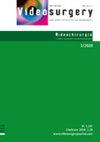Thoracoscopic treatment of iatrogenic injuries of the tracheobronchial tree: a retrospective analysis of 5 cases and review of the literature
IF 1.6
4区 医学
Q2 SURGERY
引用次数: 0
Abstract
Introduction Iatrogenic injuries to the trachea and main bronchi present one of the most dramatic complications traditionally treated by thoracotomy and transcervical-transtracheal approaches but almost never by video-assisted thoracic surgery. Aim To evaluate our experience in a video-assisted thoracic surgery repair of iatrogenic tracheal lacerations. Material and methods The group under analysis consisted of 5 consecutive patients (1 male, mean age: 52 years, range: 32–56 years) who were treated for postintubation and intraoperative damage to the tracheobronchial tree using video-assisted thoracic surgery within the period 2015–2018. Thoracic computed tomography and fibreoptic tracheobronchoscopy were used to confirm iatrogenic tracheal ruptures before surgery. The membranous rupture of the trachea was closed with interrupted absorbable sutures, which were additionally sutured through the oesophageal wall or the wall of the gastric conduit to strengthen the suture line. Postoperative treatment included broad-spectrum antibiotic therapy and control tracheobronchoscopy. Results The average duration of thoracoscopic tracheal rupture repair with suture line reinforcement was 103 min (range: 60–180 min). All patients were treated thoracoscopically without resorting to open surgery and were discharged without any postoperative complications within 16 days (range: 8–22 days). Conclusions The minimally invasive thoracoscopic approach may be the method of choice for the treatment of intraoperative and post-intubation injuries of the tracheobronchial tree.胸腔镜治疗医源性气管支气管树损伤5例并文献复习
气管和主支气管的医源性损伤是最严重的并发症之一,传统上采用开胸和经颈经气管入路治疗,但几乎从不采用电视辅助胸外科手术。目的总结胸外科视频辅助治疗医源性气管撕裂伤的经验。材料与方法分析组为2015-2018年间连续5例(1例男性,平均年龄52岁,范围32-56岁)采用胸外科视频辅助手术治疗气管支气管树插管后及术中损伤的患者。术前使用胸部计算机断层扫描和纤维气管支气管镜检查确认医源性气管破裂。气管膜性破裂处用间断的可吸收缝合线缝合,并通过食管壁或胃导管壁缝合以加强缝合线。术后治疗包括广谱抗生素治疗和对照气管支气管镜检查。结果胸腔镜下缝线加固气管破裂修补术平均耗时103 min(范围60 ~ 180 min)。所有患者均行胸腔镜治疗,未行开腹手术,16天(8-22天)内无术后并发症出院。结论微创胸腔镜是治疗气管支气管树术中及插管后损伤的理想方法。
本文章由计算机程序翻译,如有差异,请以英文原文为准。
求助全文
约1分钟内获得全文
求助全文
来源期刊
CiteScore
2.80
自引率
23.50%
发文量
48
审稿时长
12 weeks
期刊介绍:
Videosurgery and other miniinvasive techniques serves as a forum for exchange of multidisciplinary experiences in fields such as: surgery, gynaecology, urology, gastroenterology, neurosurgery, ENT surgery, cardiac surgery, anaesthesiology and radiology, as well as other branches of medicine dealing with miniinvasive techniques.

 求助内容:
求助内容: 应助结果提醒方式:
应助结果提醒方式:


